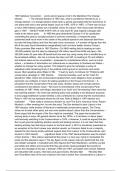Summary
Summary All of Paper 1
- Module
- Whole Course
- Institution
- AQA
This document contains key information covering the whole of UK Politics for AQA Politics: Paper 1. I created these flashcards myself using the AQA Hodder Text Book and my own resources. You can copy the information and then input into a digital flashcards website, or make your own notes off of it....
[Show more]



